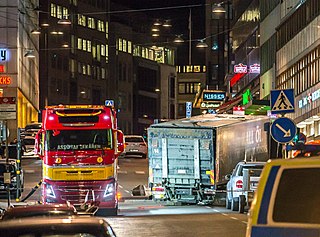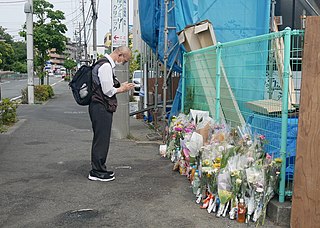
Homicide is an act in which a human causes the death of another human.
The concept of justifiable homicide in criminal law is a defense to culpable homicide. Generally, there is a burden to produce exculpatory evidence in the legal defense of justification.
Suicide by cop, also known as suicide by police or law-enforcement-assisted suicide, is a suicide method in which a suicidal individual deliberately behaves in a threatening manner, with intent to provoke a lethal response from a public safety or law enforcement officer to end their own life.
A lone wolf attack, or lone actor attack, is a particular kind of mass murder, committed in a public setting by an individual who plans and commits the act on their own. In the United States, such attacks are usually committed with firearms. In other countries, knives are sometimes used to commit mass stabbings. Although definitions vary, most databases require a minimum of four victims for the event to be considered a mass murder.

Gun violence is a term of political, economic and sociological interest referring to the tens of thousands of annual firearms-related deaths and injuries occurring in the United States. In 2022, up to 100 daily fatalities and hundreds of daily injuries were attributable to gun violence in the United States. In 2018, the most recent year for which data are available, the Centers for Disease Control and Prevention's (CDC) National Center for Health Statistics reported 38,390 deaths by firearm, of which 24,432 were suicides. The national rate of firearm deaths rose from 10.3 people for every 100,000 in 1999 to 11.9 people per 100,000 in 2018, equating to over 109 daily deaths. In 2010, there were 19,392 firearm-related suicides, and 11,078 firearm-related homicides in the U.S. In 2010, 358 murders were reported involving a rifle while 6,009 were reported involving a handgun; another 1,939 were reported with an unspecified type of firearm. In 2011, a total of 478,400 fatal and nonfatal violent crimes were committed with a firearm.

Figures on crime in London are based primarily on two sets of statistics: the Crime Survey for England and Wales (CSEW) and police recorded crime data. Greater London is generally served by three police forces; the Metropolitan Police which is responsible for policing the vast majority of the capital, the City of London Police which is responsible for The Square Mile of the City of London and the British Transport Police, which polices the national rail network and the London Underground. A fourth police force in London, the Ministry of Defence Police, do not generally become involved with policing the general public. London also has a number of small constabularies for policing parks. Within the Home Office crime statistic publications, Greater London is referred to as the London Region.

A mass shooting is a violent crime in which one or more attackers kill or injure multiple individuals simultaneously using a firearm. There is no widely accepted definition of "mass shooting" and different organizations tracking such incidents use different definitions. Definitions of mass shootings exclude warfare and sometimes exclude instances of gang violence, armed robberies, familicides and terrorism. The perpetrator of an ongoing mass shooting may be referred to as an active shooter.
The 2012 Yecheng attack was a terrorist attack by Uyghur separatist extremists that occurred on February 28, 2012, in Yecheng, Xinjiang, a remote town situated about 150 miles from China's border with Pakistan. Details of the attack are disputed: according to Chinese government reports and court documents, at around 6 p.m. that day, a group of eight Uyghur men led by religious extremist Abudukeremu Mamuti attacked pedestrians with axes and knives on Happiness Road. Local police fought with the attackers, ultimately killing all and capturing Mamuti. State-run media reported that one police officer died and four police were injured, while 15 pedestrians died from Mamuti's assault and 14 more civilians were injured. Chinese officials characterized the event as a "terrorist attack."

A vehicle-ramming attack, also known as a vehicle as a weapon or VAW attack, is an assault in which a perpetrator deliberately rams a vehicle into a building, people, or another vehicle. According to Stratfor Global Intelligence analysts, this attack represents a relatively new militant tactic that could prove more difficult to prevent than suicide bombings.

Mass shootings are incidents involving multiple victims of firearm related violence. Definitions vary, with no single, broadly accepted definition. One definition is an act of public firearm violence—excluding gang killings, domestic violence, or terrorist acts sponsored by an organization—in which a shooter kills at least four victims. Using this definition, a 2016 study found that nearly one-third of the world's public mass shootings between 1966 and 2012 occurred in the United States, In 2017 The New York Times recorded the same total of mass shootings for that span of years. A 2023 report published in JAMA covering 2014 to 2022, found there had been 4,011 mass shootings in the US, most frequent around the southeastern U.S. and Illinois. This was true for mass shootings that were crime-violence, social-violence, and domestic violence-related. The highest rate was found in the District of Columbia, followed by Louisiana and Illinois.

The Sagamihara stabbings were committed on 26 July 2016 in Midori Ward, Sagamihara, Kanagawa, Japan. Nineteen people were killed and twenty-six others were injured, thirteen severely, at a care home for disabled people. The crimes were committed by a 26-year-old man, identified as Satoshi Uematsu, a former employee of the care facility. Uematsu surrendered at a nearby police station with a bag of knives and was subsequently arrested. Justin McCurry of The Guardian described the attack as one of the worst crimes committed on Japanese soil in modern history. Uematsu was sentenced to death on 16 March 2020, after the prosecution sought the maximum penalty for murder in his trial; as of July 2022, he was on death row awaiting execution. As of 2023, it is currently the deadliest mass stabbing in Japanese history.
Stabbing attacks, which have been used as a tactic for thousands of years, became an increasingly common form of terrorism targeting random civilians in the 21st century, in particular during the 2010s and 2020s.

The Kawasaki stabbings occurred on the morning of 28 May 2019 in the Tama ward of Kawasaki City, Kanagawa Prefecture, Japan, four blocks west of Noborito Station. Two people were murdered, and 18 others were injured after being stabbed at a city bus stop by 51-year-old Ryuichi Iwasaki. After carrying out the attack, Iwasaki committed suicide by stabbing himself in the neck.

On 20 June 2020, shortly before 19:00 BST, a man with a knife attacked people who were socialising in Forbury Gardens, Reading, Berkshire, United Kingdom. Three men died from their wounds, and three other people were seriously injured. Khairi Saadallah, a 25-year-old Libyan male refugee, was arrested shortly afterwards. Saadallah was a former member of the Libyan militant group Ansar al-Sharia. He was charged with three counts of murder and three counts of attempted murder; he pleaded guilty. In January 2021, Saadallah was sentenced to a whole-life term.

On 3 September 2021 at 14:40 NZST, eight people were injured in a mass stabbing at the LynnMall Countdown supermarket in New Lynn, Auckland, New Zealand. The attacker, Ahamed Samsudeen, was being followed by police officers, who intervened during the attack and shot and killed him after he charged the officers. He was pronounced dead at the scene. The incident was treated as terrorism and was "ISIS-inspired" according to Prime Minister Jacinda Ardern. It was the second stabbing in less than four months to occur at a Countdown supermarket, the first being in Dunedin, and the first terrorist attack in New Zealand since the Christchurch mosque shootings in 2019.
On March 22, 2022, four people were killed and two more were injured during a stabbing and vehicle-ramming attack by an Islamic State supporter in Beersheba, Israel.











